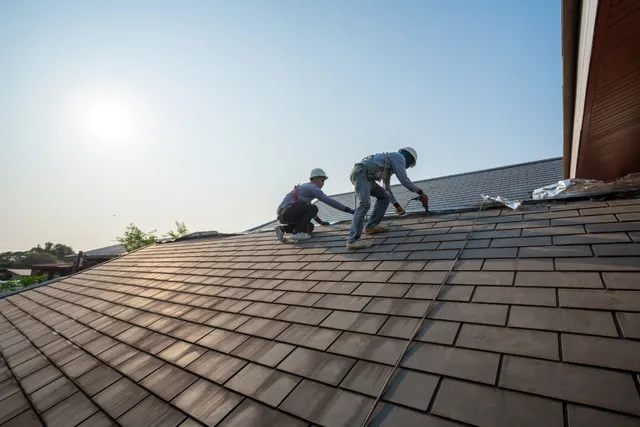Choosing the right roofing material is crucial for homeowners, especially in regions prone to heavy rainfall. The United States experiences a wide range of climates, and areas with significant precipitation require roofing that can effectively repel moisture, prevent leaks, and endure harsh weather conditions. This blog post will delve into the best roofing materials for rainy climates by Best Roofing Companies, discussing their advantages, disadvantages, and suitability for different types of homes.
Understanding the Importance of Roofing Materials
Roofing serves as the first line of defense against rain, snow, and other environmental factors. In regions with heavy rainfall, it’s essential to choose materials that not only repel water but also resist mold growth and withstand strong winds. The right roofing material can enhance your home’s durability and longevity while providing peace of mind during stormy weather.
Factors to Consider When Choosing Roofing Materials
Before diving into specific materials, it’s important to consider several factors that influence your choice:
- Climate: The amount of rainfall and wind speed in your area will dictate which materials are most suitable.
- Durability: Look for materials that can withstand heavy moisture without deteriorating.
- Maintenance: Some roofing materials require more upkeep than others. Consider how much time and effort you’re willing to invest.
- Cost: Budget plays a significant role in your decision. Some materials are more expensive upfront but may save you money in the long run due to their durability.
- Aesthetics: The appearance of your roof can affect your home’s curb appeal. Choose a material that complements your home’s design.
Best Roofing Material for Rainy Climates
1. Metal Roofing:
In recent years, metal roofing has become increasingly popular because of its remarkable durability and resistance to water. Made from materials such as steel or aluminum, metal roofs can last 40 to 70 years with minimal maintenance. One of the key benefits of metal roofing is its ability to shed water efficiently. The smooth surface allows rain to slide off easily, reducing the risk of leaks.
Additionally, metal roofs are highly resistant to wind damage, making them suitable for areas prone to storms. They can resist speed winds of up to 140 miles per hour. However, homeowners should be aware that metal roofs can be noisier during rainstorms unless properly insulated. Despite this drawback, their longevity and resilience make them an excellent choice for rainy climates.
Advantages of Metal Roofing
- Durability: Metal roofs can last for many decades, minimizing the need for regular replacements.
- Energy Efficiency: Reflective metal surfaces can help reduce cooling costs in warmer months.
- Minimal Maintenance: Metal roofs demand less upkeep than traditional shingles.
Disadvantages of Metal Roofing
- Cost: The initial investment can be higher than asphalt shingles.
- Noise: Without proper insulation, metal roofs can amplify sound during heavy rain.
Suggested read: Big Brother 2024 Winner Season 26: Chelsie Baham Takes Home $750,000
2. Slate Roofing:
Slate roofing is another premium option for homeowners looking for durability in wet conditions. Known for its longevity, slate can last over a century if maintained properly. Its dense structure makes it highly resistant to water absorption, preventing leaks and water damage.
While slate roofs are attractive and can significantly increase a home’s value, there are various factors to take into account. The slate is heavy and may require additional structural support during installation. Furthermore, it is one of the more expensive roofing options available. For those willing to invest in a long-lasting roof that performs exceptionally well in rainy climates, slate is an outstanding choice.
Advantages of Slate Roofing
- Aesthetic Appeal: Slate offers a unique look that enhances curb appeal.
- Durability: With proper maintenance, slate roofs can last over 100 years.
- Water Resistance: Slate’s natural properties make it highly resistant to moisture.
Disadvantages of Slate Roofing
- Weight: The heavy nature of the slate may require additional structural support.
- Expense: Slate roofing ranks among the most costly options on the market.
3. Clay and Concrete Tiles:
Clay and concrete tiles are popular choices in areas with heavy rainfall due to their durability and water resistance. These materials are designed to withstand intense weather conditions while providing excellent insulation. Clay tiles are particularly effective at shedding water and preventing mold growth.
However, both clay and concrete tiles are heavy materials that may necessitate reinforced roofing structures. They also tend to be more expensive than asphalt shingles but offer long-term benefits through their longevity—often lasting 50 years or more. Homeowners should consider their home’s structural capacity before opting for tile roofing.
Advantages of Clay and Concrete Tiles
- Longevity: These tiles can last decades with minimal maintenance.
- Energy Efficiency: Their insulating characteristics assist in maintaining comfortable indoor temperatures.
- Fire Resistance: Clay and concrete tiles are resistant to fire.
Disadvantages of Clay and Concrete Tiles
- Weight: Additional structural support may be required.
- Expense: Requires a greater initial investment than other materials.
4. Asphalt Shingles:
Asphalt shingles remain one of the most popular roofing materials in the United States due to their affordability and ease of installation. While they do not last as long as metal or slate roofs, typically around 20 to 30 years. They offer decent protection against rain when properly installed.
High-quality asphalt shingles come with improved water resistance features that make them suitable for rainy climates. They come in a variety of styles and colors, enabling homeowners to select an aesthetic that enhances their home’s design. However, it’s worth noting that asphalt shingles may not perform as well in extreme weather conditions compared to other materials.
Advantages of Asphalt Shingles
- Affordability: Asphalt shingles are one of the most profitable options available.
- Diversity: They are available in a broad range of colors and styles.
- Ease of Installation: A quick installation process reduces labor costs.
Disadvantages of Asphalt Shingles
- Shorter Lifespan: Typically lasts only 20-30 years.
- Susceptibility to Weather Damage: May not hold up as well under extreme conditions.
5. Synthetic Roofing Materials:
Synthetic roofing materials have emerged as a modern alternative that combines the best features of traditional materials while minimizing their drawbacks. Made from plastic or rubber composites, synthetic roofs are designed to mimic the appearance of wood shakes or slate while providing superior water resistance.
These materials are lightweight yet durable enough to withstand heavy rain and wind. They also require less maintenance than wood shingles and do not suffer from issues like rot or insect infestation. Although synthetic roofing can be more expensive upfront compared to asphalt shingles, its longevity and performance make it a worthwhile investment for rainy climates.
Advantages of Synthetic Roofing Materials
- Lightweight: Easier on your home’s structure compared to heavier options like slate or tile.
- Low Maintenance: Resistant to rot and pests.
- Aesthetic Variety: Available in various styles mimicking traditional materials.
Disadvantages of Synthetic Roofing Materials
- Cost: Initial investment may be higher than traditional asphalt shingles.
- Newer Technology: Some homeowners may prefer established materials over newer options.
6. Wood Shingles:
Wood shingles offer a natural look that many homeowners find appealing. However, they are generally not recommended for areas with heavy rainfall due to their susceptibility to mold and rot. While treated wood can provide some level of water resistance, it still requires regular maintenance to prevent damage from moisture.
In rainy climates, wood shingles can absorb water over time, leading to warping or decay. If you prefer wood for its aesthetic qualities, consider using it in combination with other materials or ensure you have a robust maintenance plan in place.
Advantages of Wood Shingles
- Natural Aesthetic: Offers a timeless appearance that boosts curb appeal.
- Insulation Properties: Offers good thermal insulation when properly maintained.
Disadvantages of Wood Shingles
- Maintenance Requirements: Requires regular upkeep to prevent rot.
- Water Absorption Issues: Susceptible to moisture-related problems in rainy climates.
Conclusion
Selecting the best roofing material for rainy climates involves careful consideration of various factors including durability, cost, aesthetics, and maintenance requirements. Metal roofing stands out for its resilience against moisture and wind, while slate offers unmatched longevity but at a higher price point.
Clay and concrete tiles offer strong protection. However, their weight necessitates additional structural support.
Clay and concrete tiles offer outstanding protection. However, their weight necessitates additional structural support. Synthetic materials present an innovative solution that balances performance with aesthetic appeal.
Ultimately, homeowners should assess their specific needs based on local climate conditions and their budget before making a decision. Consulting with a professional roofer can also provide valuable insights tailored to your home’s requirements. Selecting the appropriate roofing material helps safeguard your home from the elements while also increasing its overall value and enhancing curb appeal.








